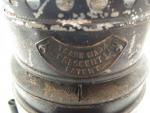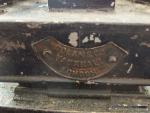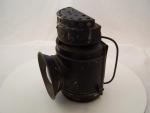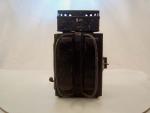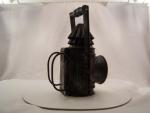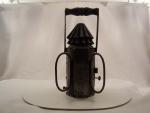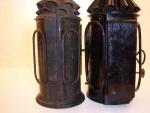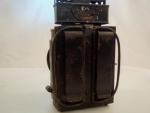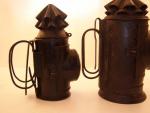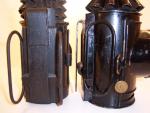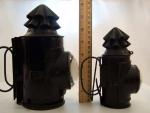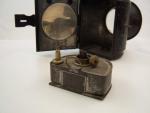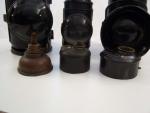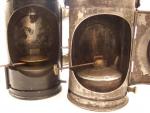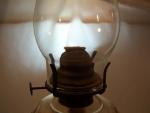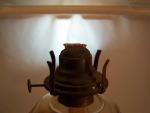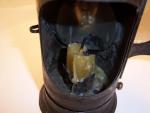-
Posts
6,486 -
Joined
-
Last visited
-
Days Won
10
Content Type
Profiles
Forums
Blogs
Gallery
Events
Store
Everything posted by Brian Wolfe
-
As indicated by the title of this section the lamp we are looking at now was patented as The Crescent Lamp by Dolan & Co. of Vauxhall, London, England. Vauxhall is located in central London and upon checking this out I found that it would appear that one could not find the very centre of the city any more accurately than being in Vauxhall. I believe one of the best know items to come out of Vauxhall was the automobile by the same name. Below I have shown the two brass plates that are riveted to the lantern.
-
The Crescent Lamp One of the most unique lanterns I’ve seen and certainly the most unique in my own collection is this one designed by Philip Bicknell, chief constable of Lincolnshire, 1856 – 1902. Lincolnshire, a predominantly agricultural area, is situated in the east of England. This particular lantern is marked on the bottom as having being issued to PC 188 Walker. To me this would suggest that the local force was small as a larger police service would probably have had someone who cleaned the lanterns daily and then simply reissued a random lantern, possibly numbered and recorded at that time, to the officers as requested. That of course is pure speculation and I stand to be corrected on this point (or any point for that matter). The first thing that strikes anyone who sees this lantern, compared with the “usual” specimens, is that the top is flat and not conical. This was done, according to Richard Cowley in his book, “A History of the British Police”, to allow a cup of tea or coffee to be rested on the top in order to keep the contents warm. I always appreciate it when manufacturers consult those who use their products in order to gain insight into designing better and, of course, more appealing items for the consumer. One of the views below shows the double hook that allows the lantern to be attached to the duty belt. Most of the other lanterns I have seen only have a single hook. We’ll also take a closer look at the innovative design features of this lantern as this article progresses.
-
Yep, a combat shotgun that even a child can use, what more could one want? Great video Chris. Regards Brian
-
Sad that this ever happens. Let us know what the metal place says. Regards Brian
-
One of the specimens in the collection also sports a wooden handle so that the lantern may be carried much like a railroad lantern. This makes me wonder if this may have been used by railway police or guards. That's pure sepeculation and I would welcome comments from other members as to this possibility.
-
The belt hook itself varied in width depending upon the manufacturer and perhaps over time, as an evolutionary development. Below is show two examples the narrow one is 1/2 inch in width and the wider one is 1 1/2 inches. The photo to the right shows a variety that has two hooks which I would think would give the lantern more stability on the belt and keep the lantern horizontal.
-
As mentioned earlier there are some main similarities common to all police lanterns, compared with lanterns designed for civilian use. These commonalities are, the double D handles and the belt hook device located at the rear of the lantern. In the collection there are a few variations on the theme and I will show them in the next series of photos. These D handles could fold back against the side of the lantern allowing the lantern to be affixed to the duty belt. In addition to the belt hook there was often found a secondary smaller hook-like device the prevented the lantern from working its way up and then falling off the belt. A few different types are also shown below.
-
I must echo Ed's comment. What a great find and the artifact has been saved, it really doesn't get better than that. Regards Brian
-
Before going any further I realized that I have made the classic error many collectors make in thinking that everyone knows the size of the item you are talking about. Most police lanterns are around 8 inches tall (20cm.). However I did come on to one that was a lot smaller and I just had to add that to the collection. As you can see in the photo it is about 6½ inches tall (16½ cm). I was showing this to a fellow I used to work with who is still a serving police officer and he laughed and commented that it probably belonged to a superintendent. The joke on the force is that a “super” never carries more than necessary. When he shows up on the crime scene he’ll ask for your flashlight and even if you have a pen. I’ve heard it said that, “let’s hope there isn’t a shoot out or the super will ask for a bullet”. Just to be fair, I’ve known one sergeant who would suggest stopping for coffee and then always say he didn’t have any cash. I wonder what he does now that there are debit cards in every coffee shop. Oh, I just remembered, he’s now a Superintendent. Regards Brian
-
Hi Tony, I use 0000 grade steel wool in my shop for finish work and have also used it on steel artifacts. There is a light machine oil with the brand name of 3in1 that works well. The lubercant seems to allow the wool to "float over the original finish yet removes the higher points which is the rust. This will not be a quick operation as 0000 is pretty fine and won't remove rust very quickly so be ready for a good deal of work. I've used this on hunting weapons which are heavily blued with small patches of corrosion with success. You can get the 4 "0" (0000) steel wool at cabinet and furniture finishing supply shops. The secondary reason I use 4"0" on cabinets is that it comes without any oil on the wool where other courser grades always comes with a coating of oil to prevent rusting while being stored. You already have the correct attitude in trying any method on a small area first. Considering the price this may be the perfect specimen to attempt a little restoration. Good luck and let us know how it turns out. Regards Brian
-
As the fine folks who brought us Monty Python’s Flying Circus would say, “And now for something completely different”, I present a burner that is not your usual variety. The lamp and the burner were designed by a police officer and I would like to take a closer look at the lamp and burner in depth later on. As you can see the shape differs and if you look closely you can see two small channels on the bottom of the lamp which correspond with channels in the bottom of the burner to more securely hold the burner in place. I'll show this more clearly when I discuss this particular lantern later. In my opinion this lantern, with its burner, was a true innovative advancement in oil burning lantern design.
-
The next three burners shown, in front of their perspective lanterns, show some different varieties of design. The one on the left is adjustable, however, this would have had to have been done while the burner was outside of the lamp to avoid burning the user’s fingers, if he wanted to increase or decrease the flame. The middle burner is missing the filler cap, however, you can see that this is an example where the wick would have had to have been advanced by hand; something that would not have been advisable if the lamp had been in use just prior to the need for a longer wick. The burner on the right has only one opening and this would have no doubt served as an opening for filling as well as allowing the cap to include some sort of wick system. It’s too bad that this is missing as it would have been an interesting example to have shown in a complete state.
-
Considering the number of years the oil burning lantern was used there is undoubtedly far more varieties than I can show here. The first two lanterns I am showing below have their burners shown in place and the method of advancing the wick is similar. There is a difference in the width of wick that would have been used in each of these two and think the wider wick would have thrown out more light.
-
After the candle burning lanterns the oil burners were introduced and the first no doubt used whale oil and later on coal oil, or Kerosene, was used. The most common use of coal oil was in residential lamps and an example of the burner and the adjustment device is shown below. I recall using these coal oil lamps, actually this particular one, when I was a young child staying at times at my Great Grand Mother’s and I can attest to the greater amount of light produced compared with a candle. Before you ask, “Just how old is this codger”, my family on my maternal side is Amish. You sure gain an appreciation for electricity, indoor plumbing, central heating and especially the indoor washroom facilities, after living “Amish” for a winter. Enough reminiscing it’s time to get back on topic. Some police lanterns required the wick to be “advanced” by hand which would be most uncomfortable, to say the least, if the lantern had been lit for some time. Others used a toothed wheel on a shaft that went to an adjustment wheel similar to the oil lamps used in residences and shown below. Later on I’ll show some of the different burner styles used. As far as maintenance was concerned, in addition to cleaning and refilling the reservoir the maintenance officer would have had to “trim the wick” which involved in cutting the wick to an even and straight edge, thereby removing the tattered burned bits left after the lamp or lantern had been used. This may not sound too difficult or important, for that matter, but that would be wrong. A wick that is frayed or uneven will not give you the best flame and therefore not the best amount of light as compared with a properly trimmed one. I tell you this in case you ever stay with an Amish family over the winter.
-
Looking at the different burner styles I thought we’d start with a candle burning lantern. The fellow I purchased this from claimed that this was a hand dipped candle from the same period as the lantern. I have my doubts about that claim, as a dipped, or tallow, candle has a different smell from this one though I have never lit it and can only say this from the fat verses wax smell when unlit. Also the wick is woven and I do not think this was the case when they dipped candles in animal fat, or used the gang moulds. Tallow, or animal fat, dipped candles go back a long way and the one thing they have in common is the amount of soot they produce while lit. I will say it has the “look” of an original and that is why I have left it in place, ugly or not. I recall seeing gang moulds used to make tallow candles which made the manufacturing of them much quicker. Wax candles that came later were more expensive but gave off less smoke and soot. If you have ever had a power shortage and had to put a candle to use for light you can appreciate that the amount of light thrown off by candle burning lanterns must have been more of a soft glow than a true beam of light. I will say that I am confident that the oil burners emitted more light than candles and in his book, “The Policeman’s Lot”, (pages 99 & 100) Mervyn tells of conducting an experiment to see how much light the oil burners produced. He reports, “I have tried lighting one of the older ones [oil burners] and found that its magnified beam was approximately half the strength of a modern 3-cell torch”.
-
Earlier we were talking about certain features being used to indicate age and while it seems to make sense (to me at least) it may not be the best method of dating. We have just looked at the devices used to deploy the blackout feature and one would think that the specimens requiring the officer to turn the internal cylinder by hand would be the oldest. However, I have a candle burner with the external knob which seems to fly in the face of what I would have thought as a good method of dating, or at least placing a relative age to the lantern in question. The concept of having next to no budget for equipment is nothing new. I swear that if I hear one more politician say, “We need to tighten our belts” or “We need to find way to do more with less” I shall scream! Anyway, budgets vary and rural constabularies may have used candle burning lanterns well after the cities were using oil burners. I’m sure that if there was a way to know for sure we would find candle, whale and coal oil burning lanterns all being used at the same time in different municipalities around Britain. The next topic we will take a look at is the different burners used in the lanterns. Regards Brian




